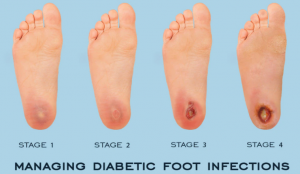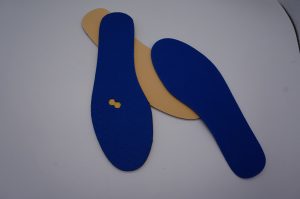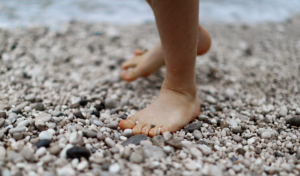Diabetes can affect almost every region of the body, from the brain to the toes. High blood sugar can lead to a variety of foot problems, so it’s critical for diabetics to give their feet some much-needed TLC. This article will act as a guide to assist diabetic people in taking the best care of their feet possible.
1. Regularly inspect your feet for cracks, wounds, and sores.
Diabetic neuropathy, or nerve degeneration, can diminish any sensation in your feet. When you have a cut, bruise, or ache, it’s possible that you won’t notice it. And this is risky since diabetic ulcers heal slowly and are susceptible to infection. So the greatest thing you can do to protect yourself against these side effects is to evaluate your foot on a regular basis for new wounds and the state of existing ones. Look for skin color changes, as well as dry or cracked skin. If they weren’t there before, this could signal the onset of diabetes-related foot problems.

2. Protect Your Feet with Diabetic Footwear and Socks
Diabetics must wear shoes and socks that fit properly. Too much pressure, insufficient space, and abrasive materials can cut the foot, which is troublesome for diabetics because diabetic wounds are more prone to become infected. As a result, diabetic footwear and socks are required. That implies shoes with deeper toe boxes will give your feet more room and will allow you to attach bespoke orthotics. Diabetic footwear also tends to be free of seams, which can irritate the skin and cause it to break. Finding diabetic footwear is fortunately pretty simple; all it requires is some help from a podiatrist or family doctor.

3. Keep Pressure Off Your Feet by Wearing Diabetic Orthotics
You should also invest in proper diabetic orthotics in addition to diabetic footwear. In addition to diabetic shoes, they provide an added layer of protection and comfort. They function by spreading pressure applied to the foot, making it less likely for cuts and injuries to become infected. Diabetic orthotics are typically insoles, with the best ones being fitted to the patient’s specific footprint. Unlike store-bought insoles, custom orthotics are shaped to protect the foot from the injuries that are more prone to occur. The best part is that a lot of these orthotics are covered by Medicare.

4. Do Not Walk Barefoot Regardless of whether you’re outside or indoors,
On a hot summer day, you might be tempted to roam around barefoot on the lawn, but this is not a good idea for diabetics. You may lose sensation in your feet if you have diabetic neuropathy. That implies you could walk right past a sharp object and get cut without realizing it. This could result in an infection of a wound or sore that you are unaware of. So the best thing to do is go for a stroll in diabetic shoes and socks. Even at home, you should practice this. Glass shards or loose nails could stay on a tiled or wooden floor, puncturing your foot without your knowledge. To protect yourself at home, use slippers or loafers with diabetic socks.

5. Take Care of Your Skin to Keep Your Feet Healthy
Diabetics should take care of their feet in the same way that non-diabetics do. Of course, they’ll have to take a different strategy. This entails clipping toenails and filing rough edges to avoid ingrown toenails, which can result in cuts and sores. Trim your nails with caution, as cutting them too short can result in cuts. Moisturizing the skin is also necessary, but finding the right balance is crucial. Because diabetics are more prone to cracks in their heels and soles, apply lotion to these regions. However, wipe away any extra lotion and avoid putting lotion in between your toes, as this might produce too much moisture, putting you at risk of infection.
6. If you currently smoke, stop.
Diabetics frequently experience poor circulation. Because cigarette chemicals restrict blood vessels, making poor circulation worse, quitting smoking is critical if you have diabetes. As a result, your feet will receive less nutrient- and oxygen-rich blood, increasing the risk of infection. Yes, quitting smoking is difficult, but it is well worth the effort for the benefit of your health. The most effective method for quitting smoking is to make a strategy and seek help. This could entail understanding and avoiding your triggers (for example, stress) or relying on nicotine patches to alleviate cravings.
7. Maintain a Diabetic-Friendly Lifestyle
This is arguably the most self-evident suggestion on the list. The foundation for avoiding diabetic foot problems is to keep your blood sugar under control through your routines (as well as other complications).
Don’t forget the fundamentals.
Test your blood sugar levels on a regular basis and take any medications advised by your doctor. Also, consume a well-balanced diet that includes blood-sugar-regulating foods and exercise often. You can keep your blood sugar in check and avoid the more serious problems of diabetes by paying attention to the basics.
8. Clean and treat wounds as soon as possible.
You’ll occasionally receive a cut or wound, which is unavoidable. Don’t be concerned. Early detection and treatment are critical in diabetic wound care. When you first see a cut or open wound, clean it with gentle soap and water and then cover it with a dry covering made for sensitive skin. More importantly, keep a close eye on the wound and check it on a frequent basis. If it takes a long time to heal and gets discolored or painful, see your doctor to have it looked at for an infection. The sooner you catch one, the more easily and quickly it will run its course.
9. Do not immerse your foot in boiling water.
You’ll have a hard time perceiving temperature extremes if diabetic neuropathy robs your feet of sensation. As a result, immersing your feet in a really hot bath tub (or taking a very hot shower) might be harmful to a diabetic foot. High temperatures can cause blisters and burns on the feet, which can easily get infected. That’s why it’s crucial to bathe or shower in only moderately hot water, rather than boiling hot water. Because your feet may not be able to detect the temperature, you’ll have to rely on other body parts to determine it. Feeling the temperature with your hands or elbows before going into the tub is a simple way to achieve this.
10. Do not cross your legs or sit for an extended period of time.
Because diabetics often have poor circulation in their feet, it’s critical that you do everything you can to promote healthy blood flow. That involves avoiding bad behaviors like sitting for lengthy periods of time with your legs crossed, which restricts circulation. It’s also important to move your feet in the proper way to promote good blood flow. To enhance blood flow, do things like wiggling your toes and moving your ankles around for a few minutes each day. This will assist to combat the poor circulation that commonly comes with diabetes, as well as make your feet more resistant to infections and nerve damage.
If you notice any unusual changes in your foot health, see a podiatrist.
Keeping track of diabetic foot health can be difficult at first. But, like with any habit, once you get into the swing of things, it will become a part of your routine and doing them will become second nature.
Family members, friends, and medical professionals such as your doctor or podiatrist can all help you. They can physically assist you with some of these jobs, making them seem less like chores, and they can also provide emotional support.
All of your efforts will be rewarded if your feet remain healthy, resilient, and free of problems.
Don’t know what diabetes orthotics and footwear you’ll need to keep your feet safe? Please contact us so that we can assist you in selecting the appropriate diabetic shoes and insoles for your needs.
Hot blogs:
The Easiest Custom Insoles: Heat Moldable Insoles
Custom insoles, also known as orthotic insoles, are designed to provide personalized support and comfort for individuals with various foot conditions. In [...]
Children’s Insole Size Conversion Chart
The standard sizes for shoe insoles may vary from country to country, making it a headache to choose the right insole for [...]
Do custom orthotics need to be made by a doctor personally?
Custom orthotics do not necessarily need to be made by a doctor personally. While doctors, specifically podiatrists or orthopedic specialists, are often [...]
Do NBA players use custom insoles?
Custom insoles are not only helpful for people with foot health issues, but they also play a significant role in targeting the [...]
